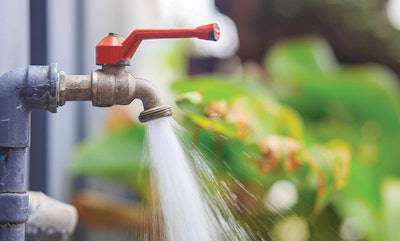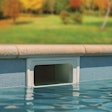
One topic that gets little attention in the pool industry is the quality of the source water used to fill pools or spas. Whether this is a new fill or topping off a pool, the quality of the water is a very important aspect of maintenance. Source water can contain many different compounds and impurities that affect the amount and type of chemicals needed to produce quality water. It is crucial to test the source water for contaminants and determine the correct treatment action to minimize the effects of these contaminants. This article identifies some of these contaminants and their effects on pool and spa water.
Source water used in pools and spas can come from several sources, the two most most common sources being municipal water and well water.
MUNICIPAL WATER
“Municipal water” is water that has been cleaned and treated in a treatment facility. Once the water is treated, it is then piped into houses or other end-use facilities. The quality of source water depends on whether the water being treated is from rivers, lakes or wells. The type and age of the source piping along with the quality of makeup water can lead to the addition of contaminants such as copper or lead. Due to the Environmental Protection Agency regulations on potable water leaving the treatment facility, such as the mandated corrosion control process, municipal water usually does not contain high concentrations of impurities. However, certain substances, even at low concentration — such as heavy metals, phosphates and nitrates — could potentially create issues in both pools and spas. Problems could also arise from source water with extremes, or wide swings in pH, total alkalinity, total hardness or total dissolved solids. There can also be organic and inorganic compounds, including chloramines and tannins, present that can lead to water quality issues in pools and spas.
WELL WATER
It is estimated that more than 13 million households rely on private wells for drinking water in the United States (U.S. Census American Housing Survey 2017). The EPA does not regulate private wells, nor does it provide recommended criteria or standards for individual wells. The EPA offers information regarding the importance of testing private wells and guidance on technologies to treat or remove any listed drinking water contaminants. Private well owners are responsible for the safety of their own water. Well water is used in many remote areas of the country as a potable water source where access to municipal water is difficult, undesired or impossible. Well water quality can vary drastically in different geographical locations. The main issues with using well water in pools and spas are high concentrations of heavy metals such as iron and copper, tannins and iron bacteria. These contaminants can cause staining of pool surfaces, precipitation and heavy sanitizer consumption. Also, well water can be contaminated by nearby septic tanks and water runoff.
RELATED: Source Water Provides the Baseline
The chemical and physical properties of municipal and well water vary regionally. The following are some of the constituents of source water that have the potential to create problems in pools and spas.
METALS
Source water can contain metals such as iron, copper, manganese, calcium and zinc. These metal constituents come from nature or are added to the water at the point of treatment. One example of this is calcium, which is added to increase the water hardness. Some of these metals can come from corrosion of metal pipes. The concentration of these metals varies in different geographical locations. Untreated well water is especially notorious for high levels of heavy metals. Wells can also contain certain bacteria, referred to as iron bacteria, that bind and carry iron. In these cases, the iron cannot be easily detected by a test because it is contained in the bacteria. Iron bacteria can result in brown-colored water and staining of pool surfaces. Metals in pools and spas can contribute to high sanitizer consumption, staining and scaling. Also, biguanide-based sanitizers can react with heavy metals such as iron and copper to form a precipitate that creates colored water and high sanitizer demand. Sequestering agents and metal-removing products can be used regularly or when fresh water is added to control metals in pools and spas.
Iron in the source water can also interfere with ultraviolet disinfection systems. For UV systems producing ultraviolet light at 254 nanometers, most manufacturers recommend reducing iron levels in the water to below 0.3 ppm to both prevent interference with ultraviolet transmittance and reduce sleeve fouling. The EPA has reported that iron levels greater than or equal to 0.2 ppm interfere with UV performance. A reduced UVT and fouled sleeve interfere with the UV dose, thereby negatively impacting the level of disinfection. Since the impact on UV performance is dependent upon both the wavelength of light generated and the temperature of the system, it is important to follow the manufacturer’s recommendations regarding allowed levels of iron and other metals in the pool water for proper operation.
CHLORAMINES
Municipal drinking water is commonly chloraminated to create a longer-lasting sanitizer residual and to limit the formation of certain EPA-regulated chlorination disinfection byproducts. Both chlorine and small amounts of ammonia are added to the water separately. They react together to form chloramines, which in pool water are detected as combined chlorine. This process mainly produces monochloramine which is less of an irritant than other common chloramines, such as dichloramine and trichloramine. Chloramine disinfection with monochloramine is used in both small and large water treatment plants. The EPA has a maximum limit of 4 ppm (as Cl2) for chloramines in drinking water. Chloramines in pool and hot tub water are removed by superchlorination. The use of UV or ozone can also help with oxidation of the inorganic chloramines present in chloraminated source water. For more information about chloramination in your area, contact your local drinking water municipality.
TDS DUE TO HIGH LEVELS OF MINERALS
TDS is the total of all dissolved solid matter such as minerals, metals, salts and contaminants in the water. Source water in some areas of the country may contain high levels of TDS mainly due to the presence of minerals such as calcium and magnesium. In areas where calcium hardness concentration exceeds 1,000 ppm, it is recommended to find another source of water that contains fewer minerals. It may be possible to address this issue by maintaining lower total alkalinity and pH levels within acceptable ranges to balance the Langelier Saturation Index. The use of anti-scaling products keeps minerals dispersed in solution.
PHOSPHATES
Municipal water treatment plants are mandated by the EPA to practice proactive corrosion control of the pipes. The EPA advises the use of phosphates as a corrosion inhibitor to protect the pipes. As a result, phosphate in high concentrations can be detected in municipal water. Phosphate is an oxidized form of phosphorous, a non-metallic element and an essential nutrient for all living organisms including bacteria and algae. Phosphate does not directly create a chlorine demand since the phosphate ion does not react with free chlorine. However, inadequate maintenance and sanitization can allow algae and bacteria to reproduce rapidly, utilizing phosphates as a nutrient. Under these circumstances, the multiplying algae or bacterial populations may cause increased chlorine demand. Phosphates can be removed by using phosphate-removing products. These products typically use a lanthanum salt to precipitate phosphate in the pool which is then removed via filtration. Biguanide-based sanitizers could react with phosphates to form a precipitate resulting in cloudy water and/or high sanitizer consumption.
RELATED: Chloramines in Source Water
NITRATES
Nitrate is an inorganic compound that occurs under a variety of conditions in the environment, both naturally and synthetically. Nitrate levels are regulated in drinking water in the U.S. The federal EPA standard for nitrate in drinking water is set at a maximum of 10 milligrams per liter which is equivalent to 10 ppm. Nitrate and nitrites are some of the most common groundwater contaminants in rural areas. Nitrate and nitrites in groundwater originate primarily from fertilizers, septic systems and manure storage or spreading operations. In pools, nitrite (NO2) is quickly oxidized to form nitrates. These additional oxygen atoms often come from hypochlorous acid (HOCl). Currently, there are no practical treatments to remove nitrates in pools and spas except with draining and diluting with fresh water that has less nitrates. Nitrates at levels above 25 ppm may lead to excessive algae problems. In many rural areas, nitrates may be present in groundwater, so testing the source water in these areas to determine the levels may be helpful. If the local water contains high concentrations of nitrate, it may be necessary to have low-nitrate fill water brought in.
PRECAUTIONS
High levels of minerals and heavy metals from source water could create many quality issues in pools and spas. It is crucial to test the source water for contaminants and determine the correct treatment action to minimize the effects of these contaminants. Water chemistry of source water should be monitored annually at a minimum, and corrective actions should be taken to adjust and maintain chemistry and water balance to recommended levels in pools and spas. Also note that annual water reports are available from your local water treatment facility. These reports will state all treatments and contaminants that have been present and at what levels. If there is any uncertainty as to the results of testing source water, it is advisable to contact the water treatment facility to gain correct information on the make-up of the source water before adding it to the pool or spa.
SUMMARY OF CHARACTERISTICS
- Source water typically includes municipal water or well water. Municipal water draws from rivers, canals, lakes and/or wells and is treated before distribution to homes and businesses. Depending on the region of the country, the water may have varying alkalinity and hardness levels. Private well water may or may not be treated, and is often a source for swimming pools. Most fill water today is treated and supplied from municipalities.
- Source water can contain a variety of minerals such as phosphates, calcium and magnesium. It can also contain heavy metals such as iron and copper and contaminants such as nitrates and organic matter. Water from wells can present many contaminants based on treatments and environmental conditions such as drought or heavy flooding.
- Water treatment facilities sometimes add minerals or other treatment chemicals depending on the water chemistry and government regulations.
- Source water may contain chlorinated disinfection byproducts which form during water treatment in treatment facilities during the chlorination of the water.
- The practice of chloramination is used by many treatment facilities to ensure proper disinfection of source water. This process combines chlorine and ammonia to produce beneficial chloramines in the water system. When topping off a pool this can lead to a temporary spike in the combined chlorine reading.
- Source water may contain organic and inorganic matter such as nitrates that are not removed by the treatment facility.











































